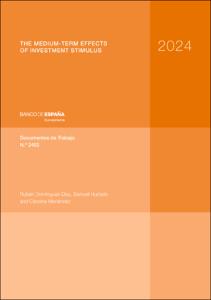The medium-term effects of investment stimulus
Authors
Issue Date
17-Jan-2024
Physical description
47 p.
Abstract
Este artículo presenta un modelo de equilibrio general y crecimiento endógeno (EGGEM) con dinámicas empresariales e inversión en innovación para la economía española, el cual permite una mejor comprensión de los efectos a medio plazo de políticas económicas y perturbaciones. El modelo se calibra usando datos agregados y datos a nivel de empresa. Una vez calibrado, se utiliza para evaluar los efectos macroeconómicos a medio plazo de los diferentes componentes de los fondos Next Generation EU (NGEU), incluyendo inversión pública, transferencias destinadas a la construcción de capital privado y transferencias dirigidas a la inversión en innovación. De acuerdo con nuestras principales simulaciones, los fondos NGEU estimularían la actividad económica significativamente, incrementando la productividad, la inversión privada y el empleo. En consecuencia, el crecimiento anual del PIB aumentaría de media en torno a 0,17 puntos porcentuales durante el período de gasto de los fondos NGEU. Entre los diferentes componentes que se consideran, se encuentra que las transferencias a la innovación tienen los mayores efectos en el output agregado, siendo estos solo comparables a la construcción de capital público si este es altamente eficiente.
This paper presents an endogenous growth general equilibrium model (EGGEM) of firm dynamics and innovative investment for the Spanish economy that allows the medium-term effects of economic policies and shocks to be better understood. The model is calibrated using both aggregate and firm-level data. It is then used to assess the medium-term macroeconomic consequences of the different components of the Next Generation EU (NGEU) programme, including public investment, private capital transfers and innovative investment transfers. According to our baseline simulation, the NGEU funds significantly foster economic activity by raising aggregate productivity, private investment and employment. As a result, annual GDP growth is increased by 0.17 percentage points on average over the period of NGEU disbursement. Among the different policy instruments considered, we find that innovation transfers have the largest impact on aggregate output, only matched by increases in the stock of public capital if it is highly efficient.
This paper presents an endogenous growth general equilibrium model (EGGEM) of firm dynamics and innovative investment for the Spanish economy that allows the medium-term effects of economic policies and shocks to be better understood. The model is calibrated using both aggregate and firm-level data. It is then used to assess the medium-term macroeconomic consequences of the different components of the Next Generation EU (NGEU) programme, including public investment, private capital transfers and innovative investment transfers. According to our baseline simulation, the NGEU funds significantly foster economic activity by raising aggregate productivity, private investment and employment. As a result, annual GDP growth is increased by 0.17 percentage points on average over the period of NGEU disbursement. Among the different policy instruments considered, we find that innovation transfers have the largest impact on aggregate output, only matched by increases in the stock of public capital if it is highly efficient.
Publish on
Documentos de Trabajo / Banco de España, 2402
Subjects
Productividad; Inversión pública; Crecimiento endógeno; Next Generation EU; Productivity; Public investment; Endogenous growth; Gasto público; Crecimiento económico; Evolución y desarrollo económicos; España
Appears in Collections:












